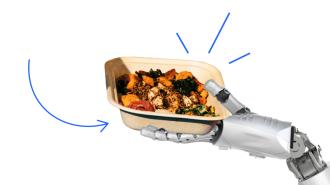What does the future of autonomous dining look like? If you’re in San Francisco, you can catch a glimpse of it in an outdoor food court that hosts the world’s first fully robotic restaurant: Mezli. Although autonomous dining isn’t exactly new, Mezli is the first spot where humans are not involved on site. Robots run the show.
As a collaboration between a group of Stanford engineers and a Michelin-starred chef, Mezli shows how restaurants can utilize robots to cut costs and provide better working conditions for workers — all while still serving up high-quality meals. And for consumers, the money saved by restaurants could mean cheaper prices on the lunch menu.
Watch the full video on Mezli:
How Mezli works
In San Francisco’s SPARK Social food court, diners walk up to a shipping container-sized building that has a touchscreen on it. They select a meal from a long list of Mediterranean-style bowls: shredded spiced lamb with tzatziki, lemon za’atar chicken, or a falafel bowl with salad — the potential ingredient combinations reach into the thousands.
Inside the building, each bowl travels on a conveyor belt as robots heat and dispense the specified ingredients into the bowl. The finished product ultimately ends up at a window where customers can grab it and go.
The only part of the food-making process that humans are involved in is the preparation of the ingredients. This is conducted in a central kitchen, where a large space allows Mezli cooks to prepare food at scale and then deliver it to the restaurant site. It’s similar to a regular restaurant: The main difference is that the cooks are ultimately delivering food to robotic servers (or, more accurately, robotic food assemblers) rather than human waiters.
Once the food is prepared, Mezli staff deliver it to the restaurant, which looks like a pleasant, if small, eatery — except there’s no front door. And there are no humans inside.
“This means [the building is] both cheaper to build and fit in smaller spaces than traditional restaurants, which will let us deploy them to lots of places to spread the availability of our high-quality, affordable meals,” Mezli notes, adding that the small size also reduces carbon footprint.
When a chef meets an engineer
In the U.S., it’s not exactly easy to find a meal that’s convenient, healthy, and affordable. That was the main observation that led Mezli founders Alex Kolchinski, Alex Gruebele, and Max Perham to come up with the idea for the restaurant as graduate students at Stanford Engineering.
The team realized that robots could cut restaurant costs — and, therefore, the cost of meals — in two key areas: space and labor. They had experience in building robots, but not in cooking high-end food. So they teamed up with Bay Area chef Eric Minnich, who’s worked in Michelin-starred restaurants.
“What really, I think, clicked for me with them was when they said, ‘Building the machine, the robot, is the easy part. It’s the food part that’s the hard part,’” Minnich said. “And I was like, ‘The food part, to me, is the easy part. The robot’s the hard part.’”
The combination of culinary and engineering smarts led to the unique approach Mezli takes to food. That approach took some research and development. After all, having robots heat and assemble food all on their own requires tweaking the ways cooks normally prepare food.
“Some of the things we purposely undercook, some of the things we purposely take a little too far,” Minnich said.
Although Minnich and his colleagues have had to adjust recipes to fit the unique production model, he emphasized that the focus is always on quality and flavor. If a certain tweak ends up making a dish worse, the cooks have to find a new way to execute the dish — perhaps by making a sauce thinner, or inventing a new recipe altogether.
Automating an evolving industry
The restaurant industry has always been a fairly difficult one for most people involved. The hours can be terrible, the pay is often low, turnover can be very high, and the profit margins often leave something to be desired — if the business lasts long enough to turn a profit.
For restauranteurs, tasking robots with food preparation can significantly cut costs. That can translate into better wages and working conditions for the people who prepare the food and oversee the rest of the production process.
“Better quality of life for the staff, more approachable hours or more manageable hours, and just not that hectic hustle and bustle and grind,” Minnich told Freethink. “With the robot, the only thing is, ‘Is it full or is it not and what does it need?’ And as long as we’re always prepared, we can always meet that.”
It might seem counterintuitive that automating kitchen operations could benefit restaurant workers. But the pandemic has made it especially difficult for restaurants to succeed in the U.S., not only because of lockdown measures and rising food costs but also because of labor shortages.
In May 2022, the industry was down about 750,000 jobs — or about 6% of the workforce — compared to pre-pandemic levels, according to the National Restaurant Association. Many of those lost jobs comprise roles like dishwashing, serving, and food preparation. If more restaurants were able to save money by automating these positions, they could potentially provide staff with better conditions and higher pay.
But despite reports suggesting that robots could replace as much as 80% of restaurant positions, it’s unlikely that restaurants (especially sit-down spots) will fundamentally change anytime soon. After all, there are certain things a machine just can’t do.
“We still want to have those date nights and those birthday dinners and to get together with friends at the bar and talk to the bartender,” Minnich said. “Robots won’t ever really have that human touch in the sense — they won’t have hospitality in the true sense of the word.”
